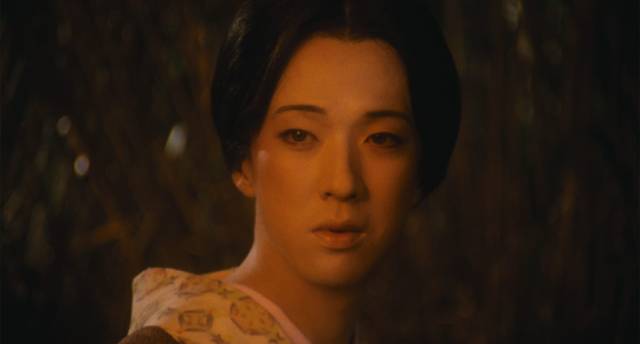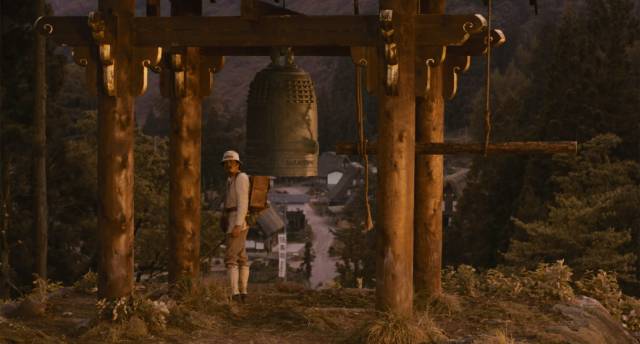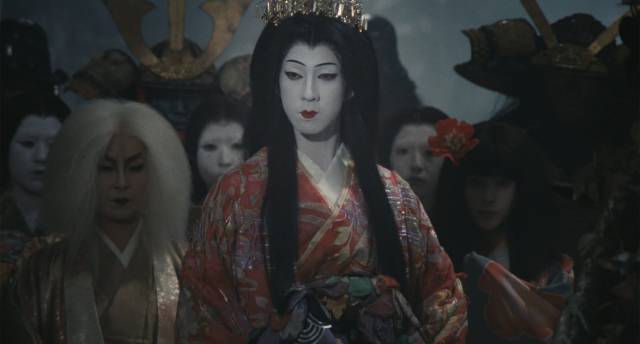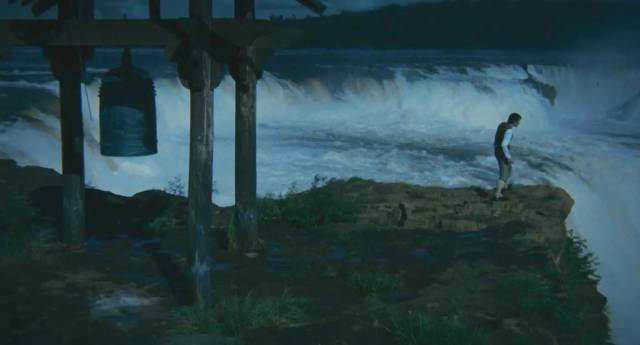Masahiro Shinoda’s Demon Pond (1979): Criterion Blu-ray review

Masahiro Shinoda was a significant figure in the Japanese New Wave of the 1960s, who worked in a wide range of styles, often with a political edge. His work ranged from the historical realism of films like Assassination (1964) and Silence (1971) to the romantic view of yakuza outlaws in Pale Flower (1964) to the stylized theatricality of Double Suicide (1969), an adaptation of a bunraku tragedy in which the actors are manipulated by puppeteers who come to represent the social forces controlling the characters’ lives. An element of fantasy rooted in Japanese folklore runs through a number of his films, perhaps none more than Demon Pond (1979), based on a 1913 play by Kyoka Izumi.
Although it begins in a seemingly realistic way, an unsettling note of surrealism gradually insinuates its way into the narrative until it becomes a full-blown fantasy rooted in the folk traditions of the Yokai, supernatural creatures who bridge the permeable divide between the material and spiritual worlds. In the film, the uneasy balance between these two realms traps both humans and spirits in a stifling stasis which threatens the survival of both. This social and historical impasse is ultimately broken by both superstition and the reactionary politics of the Imperial state, climaxing in a literal explosion which sweeps away what has become untenable, leaving open an as-yet-undefined possible new way.

In the opening sequence, botanist Yamazawa (Tsutomu Yamazaki) walks across a parched landscape under a scorching sun, eventually running out of water. The first unsettling note is his discovery of a doll inexplicably lying on the sand. He finally enters an area of hills and forest, coming to a seemingly abandoned village. Asking the first people he sees for water, he’s told there is none, that the region is suffering a long-running drought. The second unsettling note comes when the wind blows dust into his eye and the innkeeper’s wife bares her breast and tries to squeeze out some milk to flush the eye.
The sombre tolling of a bell draws him up the hill overlooking the village, where the remains of a temple stand. He encounters a strangely aetherial woman beside a stream, apparently the only water in the region. As he speaks to her, a figure watches silently from inside the building. Night begins to fall and the figure eventually reveals himself to be Akira (Gô Katô), an old friend who vanished years before. Yamazawa learns that his friend had come to this region and encountered Yatabei (Jun Hamamura), a man whose life was devoted to ringing the bell three times a day, a ritual which prevents the nearby Demon Pond from overflowing and destroying the valley.

When the man died, Akira took on his role, also marrying the man’s wife Yuri (Tamasaburô Bandô). Yamazawa tries to persuade Akira to leave with him, to return to the modern world, but he claims to be unshakably committed to his responsibility for protecting the area. At which point the film takes a sharp turn into fantasy as a poacher catches a carp in the nearby pond only to drop it when a crab pinches his foot – and both carp and crab assume semi-human form and plunge into the Demon Pond, at the bottom of which live numerous Yokai ruled over by Princess Shirayuki (also played by Bandô). These spirits are held in place by the ritual ringing of the bell, but long to be free.
Oppressed by the drought, the villagers have become hostile to the couple on the hill, wanting to unblock the lake regardless of the risk. When a pompous politician (Ryûnosuke Kaneda) arrives with a supply of rice for the village, he stirs up these resentments and superstitions and the villagers decide that they must make a sacrifice to end the drought – and they decide that it must be Yuri, who seems herself to bridge the divide between the material and spiritual realms.

As Akira and Yamazawa try to fend off the angry mob, the time for the bell-ringing passes and the film abruptly erupts into a display of miniature and optical effects which rival the work of Eiji Tsuburaya in the golden age of Toho fantasy. These were accomplished by a team headed by Nobuo Yajima, who most recently had created the effects for Kenji Fukasaku’s Message from Space (1978) and Tatsumi Kumashiro’s Jigoku (1979). Beginning with an explosive pillar of water rising in the sky as the repressed energy of the trapped Yokai is released, a catastrophic flood pours down through the valley washing away the village and its inhabitants. Only Yamazawa seems to survive, deposited on an outcrop in the middle of a vast river, above a great waterfall. An entire world, trapped in moribund stasis, has been washed away, the destruction of a whole society apparently necessary for history to begin moving forward again.
*

Shinoda manages to blend multiple styles into a coherent allegory of Japan’s tumultuous Twentieth-Century history, the oppressive clinging to a stagnant past which led to the militarism which in turn led to the catastrophic destruction of the Second World War, out of which a more modern society emerged. Between the sense of realism in the opening section and the destructive spectacle of the climax, Shinoda drew on the traditions of Japanese theatre, particularly Kabuki, for the descent into the underwater realm where the primal energies of the natural world were being repressed.
The key link between the two realms is the presence of Tamasaburô Bandô in the dual roles of Yuri and Princess Shirayuki. Bandô is one of the foremost onnagata, an actor who specializes in performing female roles in Kabuki, who was persuaded by Shinoda to make his screen debut in Demon Pond. His performance of Yuri in particular has an otherworldly quality which imbues the film with its sense of the spiritual energies represented by the Yokai, natural forces which, undeniably destructive in their power, are nonetheless a positive counterpoint to the negative influence of human beings whose own energies are dangerously misdirected.
*
The Disk
Criterion’s 4K restoration from the original camera negative has predominant earth tones befitting the drought-ridden landscape. The frequent darkness of the image emphasizes the oppressive aspects of the setting and narrative, while nonetheless offering a great deal of detail.
The Supplements
There are only two fairly brief special features: an interview with film scholar Dudley Andrew (18:12), in which he speaks enthusiastically about the film and Shinoda’s position in Japanese cinema; and a piece ported over from a French edition in which Fabien Mauro discusses Nobuo Yajima’s impressive effects (12:46).
The booklet essay is by critic Michael Atkinson.
Comments